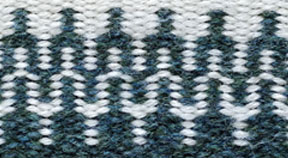The krokbragd sampler is coming along nicely. I'm very much enjoying the design process and working with a limited palette of colours. A trawl of the internet reveals there are lots of examples of krokbragd with a rainbow of colours but I felt drawn to some of the more muted colour schemes. Don't get me wrong some of those brightly coloured designs are gorgeous - okay, they're all gorgeous it's in the nature of the weave - but I like my decor to be more gentle on the eye, the colours of the coastal landscape are my go to paint samples.
I toyed with the idea of going all natural and maybe sourcing some undyed alpaca but decided to work with what I already had rather than splash the cash. After all I bought that yarn because I thought it was lovely and letting it sit in a box isn't the best way to use it.
After trying colours against each other I chose some British wool I'd bought from a weaver in Scotland who was having a de-stash. I decided to use just three colours throughout the sampler - cream, blue and green - to let the patterns speak for themselves rather than let the colours be the star of the show.
The first image is overlapping bars. I think of it as being a more modernist take on krokbragd. With bars of various lengths it could make for a very interesting pattern and kind of reminds me of some of Anni Albers' weaving. Perhaps not up there with the Bauhaus trained weavers but it has a pleasing rhythm when you see it across the width of the fabric.
The second pattern I think of as interlocking tuning forks. There is something fascinating about the way the patterns interlock and change colour at the same time. Perhaps if MC Escher had been a weaver this is the kind of pattern he might have come up with. I think it deserves a variation with more colours to really show off the colour changes. One to think about when I'm back to the design sheet.
So that's a little taster of what I've been working on and I've enjoyed the process so much that I took some of the money I saved by not buying a load of alpaca and finally bought a set of double heddle blocks for my 24" loom. I had considered selling it a while back but now I am going to warp it up and make myself a lusciously thick krokbragd mat for the bedroom. Just the thing to step onto when the mornings get cold again.
So what's inspiring your work at the moment? Why not share it in a comment



